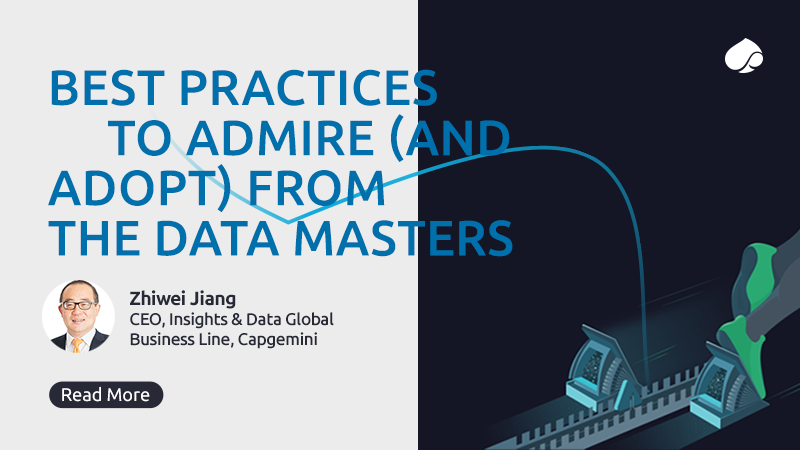Best practices to admire (and adopt) from the data masters
Blog: Capgemini CTO Blog
How many of you have ever stopped to admire an organization’s mastery of data? I have, numerous times, but I suspect I’m in the minority!
There are certainly many more exciting – and visible – company outputs to admire. Record financial results, obviously. A game-changing new product. Or even an impressive CSR initiative.
But in today’s operating environment, rife with the new competition and systemic shocks, organizations are forced to continuously evaluate and fine tune every strategic decision they make.
Their ability to utilize data effectively to inform these decisions – or “data mastery” – is critical.
However, our research shows that only 16% of organizations are able to effectively do this and claim the title of ‘data master’.
That’s why the Capgemini Research Institute has put together a brand-new report, ‘Data mastery: How data-powered organizations outperform their competitors’.
The report speaks to executives and experts within this elite group of data masters, as well as from high-performing big-tech and digital-native companies, to pinpoint a few best practices that set data masters apart.
I don’t want to give too much away, so here’s a quick preview of what’s inside.
Strategize: Let your business goals drive your data strategy
It’s easy to lose sight of what your organization is actually working towards, particularly with the massive amounts of data being generated. By starting with the business’s strategic priorities and specific problems, data masters are better able to define a data strategy that will lead them to the desired end goal.
It’s also a good way to ensure that you don’t get distracted by the tech. Technology should enable the solution; it rarely is the solution itself. As Sameer Amin, Global Director of Data-driven Marketing & Media at Reckitt Benckiser, one of the experts quoted in the report said: “If you start off with technology first, what you end up doing is buying a Ferrari and only driving in first gear.”
Plus, being deliberate about your data strategy stops your organization from accumulating “dark data” – digital info that is not being used, but still incurs storage costs, adds to your CO2 footprint, and carries regulatory compliance risks.
Entrust: Bridge the data trust gap
The IT-facing arm of an organization is arguably the holder of the keys to the data kingdom. Unfortunately, our research revealed a massive trust gap between IT and business units, with only 20% of business executives saying that they trust the data they get.
How do you fix this? Data masters employ a three-part strategy: investing in data of good quality, establishing guidelines to ensure trusted, ethical AI solutions, and focusing on data democratization.
The report goes much deeper into these steps, but for me, it all boils down to education and a healthy respect for the value of data.
Data masters understand the potential of making high-quality data available, particularly when it is used to power transformative technologies like AI. They then educate their teams – all of their teams – allowing them to utilize this data in ways that are both ethical and effective.
Modernize: Revamp your data landscape
I know, I know. I’m preaching to the choir by mentioning the need to modernize IT systems. But it’s not an easy task, especially at the rate that tools and technologies are advancing. We’re talking about years of work, tens of millions of dollars and the real risk of market position loss.
Data masters combat these challenges using a few strategic steps:
- They prioritize the value streams, products, services that align with their defined business strategy (remember Practice 1?).
- They decommission legacy systems in phases. Rome wasn’t built in a day, and it wasn’t dismantled in one either.
- They migrate data to multi-cloud environments, while ensuring integration and interoperability across the organization and between vendors.
- They customize data-discovery tools, taking a cue from digital-native companies such as Facebook, Airbnb, Netflix and Uber.
- They accelerate innovation with DataOps – a fusion of technology, processes, and people, which allows them to directly connect data consumers with data creators.
Activate: Turn data into results
It’s not enough to just have the data or even the insights.
Data organizations need to “activate” it, transforming data and insights into decisions and actions that create tangible business outcomes.
Let’s look at two examples from the report.
First up: UPS. By activating data gathered from IoT sensors in parcel-processing facilities and delivery vehicles, UPS were able to reduce average delivery time by a day in 63% of the areas they serve.
Or Ford Motor Company, who activated data from over 4,600 internal and external sources to launch a new business model for the modern customer – a usage-based auto insurance program.
Organizations can also activate data to launch new products, enable business resilience, power social innovation… essentially, all the things that we usually admire companies for!
Data masters don’t just undergo a technical transformation. They achieve an organizational and cultural one as well. They have a holistic “data-powered” approach, which includes having the right operating model, integrating data-powered innovation across the entire value chain, and fostering a data-powered culture across all levels of management.
When organizations get this right, the results speak for themselves.
But don’t just take my word for it.
Not only does the report dive deeper into these four steps, but it’s also packed with stories showing data masters in action – and the lessons we can learn from them.
So if you’ve never admired an organization for its data mastery, I promise you one thing: that’s about to change.
Leave a Comment
You must be logged in to post a comment.








